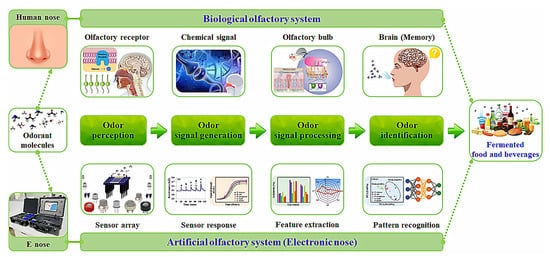You're using an outdated browser. Please upgrade to a modern browser for the best experience.
Please note this is a comparison between Version 1 by Chatchawal Wongchoosuk and Version 4 by Chatchawal Wongchoosuk.
Fermented foods and beverages have become a part of daily diets in several societies around the world. Emitted volatile organic compounds play an important role in the determination of the chemical composition and other information of fermented foods and beverages. Electronic nose (E-nose) technologies enable non-destructive measurement and fast analysis, have low operating costs and simplicity, and have been employed for this purpose.
- E-nose
- gas sensor
- Electronic nose
- electronic sensing
- odor assessment
- chemosensor
- Machine olfaction
- sense of smell
- Artificial Intelligence
1. Introduction
Due to uncertainties and unpredictable crisis situations (e.g., war conflicts) and global pandemics, the demand for fermented food and beverages has been significantly increasing because they are easy to cook and have a long shelf life [1]. In the production of fermented foods and beverages, different types of microorganisms, such as bacteria, yeast and mold, have been used to modify the chemical composition, resulting in changes in taste, smell, color and nutrients. For example, fermentation with probiotic microorganisms such as a lactic acid bacterium in products such as yogurt, kefir and kimchi can increase the nutritional value, for example, by reducing cholesterol and promoting healthy digestive function [2]. In countries, the fermentation technique has been developed specifically from local wisdom to large-scale manufacturing industries by selecting pure microbial strains, resulting in unique fermented foods and beverage products, such as pla ra (fermented fish) in Thailand, Chinese kombucha, Indonesian tempeh, natto and miso in Japan, Korean kimchi, etc. In the fermentation process, microorganisms can produce a variety of enzymes to modify food precursors. For example, the fermentation of natto employs bacteria of the genus Bacillus to create a fibrous texture that is sticky and stretchy [3]. The fermentation of coconut water (nata de coco) is produced via the bacterium Acetobacter xylinum [4]. Fermented tofu employs Monascus purpureus [5]. Different microorganisms make products with distinctive flavor compounds, nutrients and shelf lives.
To assess the quality of fermented food and beverages, such as the physical quality, nutrition value, microbiological quality, safety and sensory quality, there have been several types of equipment and techniques developed, ranging from spectroscopies to sensory evaluation techniques [6][7][8][9][10][6,7,8,9,10]. Equipment and methods enabling non-destructive measurement, rapid analysis and on-site testing with low operating costs and simplicity have received great interest in recent years. One of the effective tools for qualitative food and beverage identification meeting these criteria is an electronic nose (E-nose). There is a global trend in the development of E-nose systems instead of standard equipment such as GC, GC/MS, SPME/GC-TOFMS, GC-IMS, etc., in the qualitative analysis of food and beverages [11][12][13][14][15][16][17][18][19][20][11,12,13,14,15,16,17,18,19,20]. Although there are a set of review articles on the E-nose in food and beverage applications, comprehensive reviews focusing on fermented food and beverages based on E-nose technology are still limited.
2. History and Basic Principle of E-Nose
One of the first reports on the E-nose was in 1982, originated by Dodd, G. H. and Persaud, K. from the University of Warwick, England [21][29]. They employed three Figaro semiconducting gas sensors as transducers. The results showed fine discriminations between odors according to the mammalian olfactory system. This pioneering work has inspired several research groups to develop E-nose systems for various applications [22][23][30,31]. The concept of the E-nose is based on mimicking the human olfactory system, as shown in Figure 1. The mechanisms, odor recognition and limitations of human olfactory perception at a molecular level were first investigated by Buck and Axel from Columbia University, USA, in 1991 [24][32]. Their discovery helped to establish new ways/ideas to develop an E-nose system instead of using complex human olfactory perception for multifunctional purposes. The human olfactory system can be considered to consist of three main parts: (I) the odor-receiving part, consisting of olfactory receptor glands and scent delivery systems [25][33], (II) the nervous system for the transmission of signals between the brain and the rest of the body and (III) a decision system that is able to recognize, identify and act on the sense of smell experienced via the brain. The mechanism of smell perception is very complex. On the basis of psychophysical testing, humans are able to discriminate > 1 trillion olfactory stimuli [26][34]. However, the emotions and age of humans have a significant effect on odor recognition and classification [27][28][29][35,36,37]. Moreover, toxic agents in the sample and testing time are crucial obstacles in the ability to identify smells via the human olfactory system. The E-nose has thus become one of the powerful tools as an alternative to human evaluation of scent in samples.
Figure 1.
Schematic diagram of E-nose device versus biological olfactory system.

Photograph and schematic diagram of a prototype portable E-nose system.
